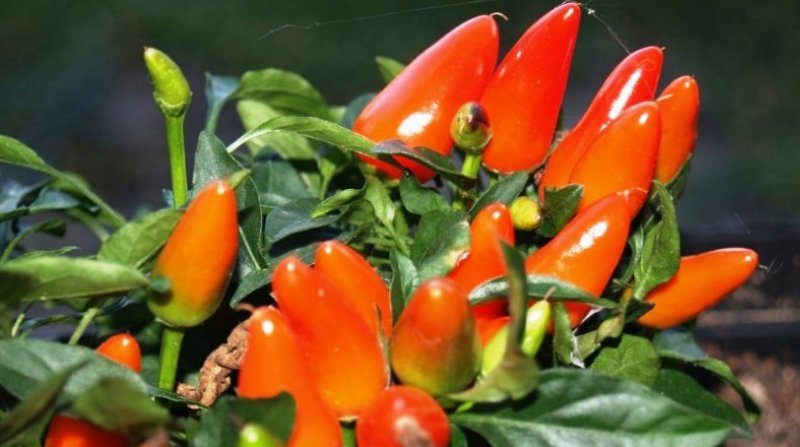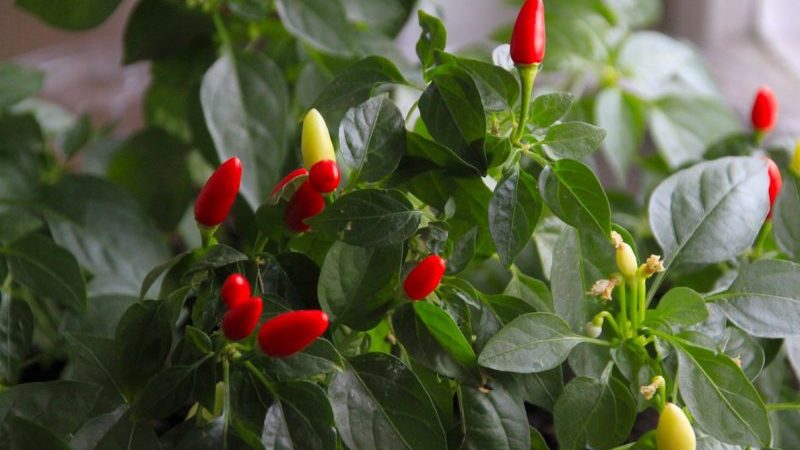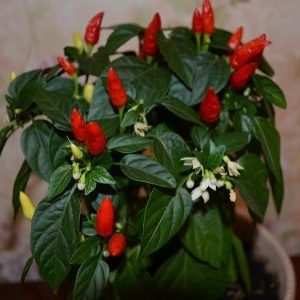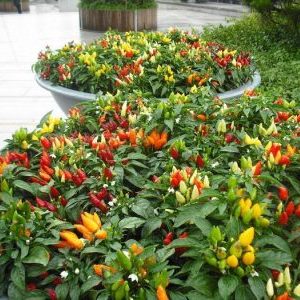Instructions for growing decorative peppers "Little Miracle" at home
There are lovers of planting tomatoes and cucumbers at their summer cottage, someone likes to pick berries in the forest, but there are also adherents of home growing plants, similar to garden and garden plants. They enthusiastically grow undersized but abundantly ripening tomatoes, cucumbers with small whips, graceful lemons on window sills and balconies.
The decorative pepper "Little Miracle" stands out among domestic crops. It is grown for various, sometimes unexpected purposes.
The content of the article
Description and characteristics of the variety
This unusual variety of pepper was bred in Holland, a country where selection work for growing fruit and vegetable crops is especially productive.
What does it look like
Fruits are small, up to 3 cm long, weighing up to 5 g. The stem can grow up to 30 cm.
Important! With good care, up to 50 ripe fruits are harvested from 1 bush.
As they ripen, the peppers change color: at first they are green, then they turn purple, orange and finally red. The color of ripe small peppers is red, like a chili variety. To taste A little miracle is exactly chili and reminds - the fruits are pungent and bitter.
 The culture is used for culinary and decorative purposes: a low green plant with bright red blotches of fruit looks great as a decoration for a room.
The culture is used for culinary and decorative purposes: a low green plant with bright red blotches of fruit looks great as a decoration for a room.
Can I eat it
The peppers grown on these bushes are small in size, but quite edible. They can be used for cooking as a hot seasoning.
Peppers of this variety are used to decorate dishes when setting a festive banquet table. Only guests need to be warned that the bright and attractive fruits have a burning taste.
Advantages and disadvantages
A distinctive culture has advantages:
- even with inattentive care, the bushes show high yields;
- the culture is not demanding on long-term lighting and soil composition;
- economical use of fruits in cooking (one pepper is enough to give a dish a characteristic taste);
- indoor bushes destroy microbes - peppers have bactericidal properties;
- alcohol and vodka tinctures are used for medicinal purposes for radiculitis and rheumatism;
- decorative properties.
The disadvantages include only a strong pungency of ripe fruits. An ignorant person or child may inadvertently eat pepper or rub the eyes by touching it. Then urgent action will be required.
Pepper is recommended to be used with caution for diseases of the pancreas and gallbladder. Uncontrolled and constant use of any spicy seasonings leads to gastritis and stomach ulcers, therefore, it is not recommended to use it as an independent food product.
Reference. Pets are not interested in this pepper.

What is needed for growing
Despite the declared unpretentiousness, pepper still requires some care. It is simple, but without it the plant will develop poorly, bear fruit poorly, or even die.
Site requirements
Peppers of this variety love direct sunlight. It is recommended to grow them on a well-lit windowsill, and in the summer to take them out to a balcony or loggia.
Important! In extreme heat, direct sunlight can be detrimental to the plant.On such days, it is recommended to store it in a cool, shaded place.
A small miracle perfectly coexists with almost all ornamental crops that are grown in apartments. Unless a large number of geraniums nearby can have a depressing effect on plant growth. But this is not noted by all growers.
Materials and tools
To grow decorative peppers you will need:
- capacity (tub, pot) with a volume of about 2 liters;

- shovel and small rake for loosening;
- scissors for pinching the stem and cutting the fruit;
- a medium sized sprayer for irrigating plants in hot weather.
It is necessary to prepare a container for settling warm water - cold watering greatly slows down the growth of the plant, the leaves dry out because of this.
How to Grow Ornamental Peppers A Little Miracle
For the successful cultivation of pepper, preparatory work will be required.
Selection and treatment of seeds, soil preparation
Seeds can be purchased at any specialty store, the variety is not rare. Before planting, they should be soaked in a weak solution of potassium permanganate for disinfection and swelling.
Traditional soil can be used. A mixture of garden soil, deciduous humus and sand is considered optimal.
Landing
Peppers of this decorative variety can be grown by seedlings and sowing seeds... Since we are talking about home cultivation without subsequent planting in open ground, preference should be given to the seed method:
- the container for planting is scalded with boiling water for disinfection;
- drainage is placed on the bottom: expanded clay, charcoal or crushed stone;
- the prepared substrate is poured on top;
- pour boiling water over;
- after cooling in the ground, make holes up to 2 cm deep;
- 2 seeds are placed in each well and sprinkled with a substrate;
- the soil is once again slightly moistened with a sprayer.
After planting is complete, the container is covered with film or glass and placed in a place where the temperature is maintained at 20-21 ° C.
Important! To prevent the formation of fungus, the film or glass must be periodically opened for a short time.
After the sprouts appear, the film is removed completely. After 10 days, the plants are placed on a lighted windowsill.
Care
Watering with warm water is carried out as the soil dries up when a light crust forms on the soil mixture. The plant needs to be sprayed periodically in hot weather to prevent the leaves from drying out. During the formation of ovaries, watering is increased and frequent.
Feed minerals should be 1 time per month. The first procedure can be performed after the appearance of the first two non-cotyledonous leaves of the future bush.
Loosening is necessary for the plant so that its underground part receives more oxygen.
Important! The lack of loosening can lead to the death of the plant due to the weak development of the root system.
Hilling is applied as the plant grows. It is carried out immediately after watering.
The top of the stem is pinched when the bush reaches 20-25 cm. This makes the bush lush, attractive from an aesthetic point of view and prevents the waste of excess juices and plant energy on excessive growth.
It is recommended that the transplant be carried out annually by the transshipment method, increasing the area of the container. Typically, such actions are performed up to 4 years.

Disease and pest control
The main illness and pests that infect peppers in the room:
- Gray mold occurs when the soil is too moist and the light is insufficient. It is destroyed by creating optimal conditions and processing the plant with soapy water.
- A spider mite enters a room with air currents, usually through an open window. Appears where the air is dry. Its presence is noticeable by the wilting leaves. The pest is removed by wet processing of the leaves.
- Aphids are destroyed with a solution of laundry soap.
Tips & Tricks
Although the agricultural technology of growing this attractive variety is not very difficult, there is subtleties that will help achieve better plant growth:
- Planting is recommended in February. Then by the summer it will be possible to harvest a full harvest.

- After the first shoots appear, it is recommended to highlight them for some time. This will raise the air temperature above the pot and extend the daylight hours.
- Fruit collection is carried out until the end of autumn.
- The first fruits can be picked when they turn yellow.
- The fruit of a dark orange or red color is finally considered ripe.
- On cloudy days and in winter-spring, it is advisable to highlight the bushes. The optimal daily light regime for peppers of this type is 18 hours.
- During flowering (and it occurs in late spring - early summer), it is recommended to shake the bush periodically slightly to improve pollination.
- As an ornamental plant, the variety can be successfully used in landscape design. The flowerbeds with densely planted small red pepper bushes look impressive even at small sizes.
- For the preparation of infusions, it is better to use ripe, aged fruits. They are collected and used together with the stalk.
Reviews
Fans of compact plants on the windowsill appreciated the versatile use of peppers. Little Miracle.
Yana, St. Petersburg: “For the first time, our experience of growing this variety was unsuccessful: the plants quickly grew up, and then wilted. It turned out that they need to be pinched and not waterlogged. But the second attempt was much more effective. The result is excellent compact peppers with characteristic bitterness and beauty. "
Semyon, Rostov: “The first time I saw such a pepper was on a neighbor's windowsill. He actively used small peppers as spices and even insisted on them vodka. We planted a Little Miracle and my wife and I. We did not regret it. I planted some of the bushes with seedlings at the dacha - it turned out to be a flower bed no worse than the one on which flowers usually grow. "
Anna, Belgorod: "I love folk healing recipes, I actively use them and treat others. Tincture on such pepper is the first remedy for sciatica and back pain. No expensive balm is needed. And it's easy to grow it, a very unpretentious plant. "
Read also:
When to remove peppers from a bush: harvest on time.
Is it possible to freeze hot peppers for the winter: we save the hot vegetable correctly.
The best sweet peppers for greenhouses in the Moscow region.
Conclusion
Not all garden crops ripen and grow on the windowsill in the apartment, including peppers. But Little Miracle is a variety specially designed for indoor conditions, it grows well indoors. A small miracle is successfully used to decorate space, prepare a variety of dishes and for medicinal purposes.